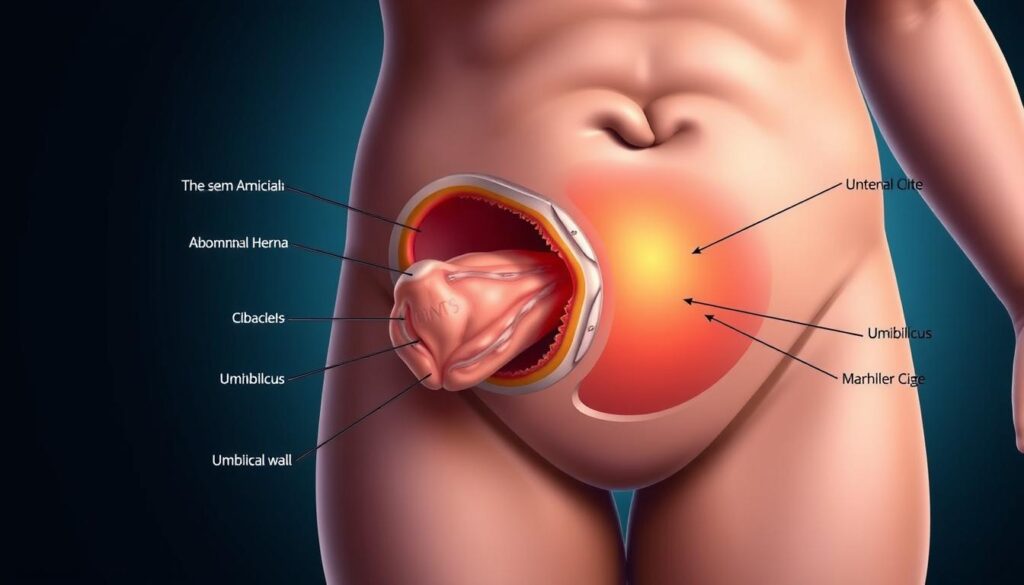An umbilical hernia creates a bulge around the belly button. It happens when part of the intestine pokes through weak abdominal muscles. These hernias are common in babies, especially preemies1.
In kids, the hernia often fixes itself by age 4 or 51. For adults, the problem can be more complicated. Various factors can lead to an umbilical hernia in grown-ups1.
Adult risk factors include being overweight and lifting heavy objects. Persistent coughs and multiple pregnancies can also cause hernias1. Grown-ups might need surgery to avoid serious issues1.
Key Takeaways
- Umbilical hernias are common in infants and can often resolve naturally
- Adults may require surgical intervention to address the hernia
- Risk factors include obesity, heavy lifting, and multiple pregnancies
- Potential complications can include obstruction and strangulation
- Most hernia repair surgeries are relatively simple procedures
What is an Umbilical Hernia
An umbilical hernia happens when tissue pushes through weak abdominal muscles near the belly button. It’s common in newborns and children. Parents should know the signs to get proper care when needed.
Common Signs and Symptoms
Umbilical hernias show up as soft bumps near the navel. In babies, they’re more visible during crying or straining. These hernias are usually painless.
Adults might feel some discomfort. The swelling often increases with physical activity.
- A visible bump near the belly button
- Swelling that increases with physical activity
- Painless in most cases
- Potential discomfort in adults
Risk Factors and Prevalence
About 20 percent of babies have umbilical hernias2. Several factors can increase the risk:
- Premature birth
- Low birth weight
- African-American ethnicity
- Obesity in adults
- Multiple pregnancies
“Most umbilical hernias in children resolve naturally by age 5,” pediatric surgeons often explain.
When to Seek Medical Attention
Most umbilical hernias are harmless. However, some cases need quick medical care. Watch for these warning signs:
- Persistent pain around the hernia
- Tender or discolored bulge
- Vomiting
- Inability to push the hernia back in
About 90 percent of children’s umbilical hernias close on their own by age 52. Adults might need surgery to avoid problems like intestinal blockage3.
Diagnosis and Treatment Options
Umbilical hernias can be worrying, but understanding your options can help. Doctors diagnose these hernias through physical exams at specialized medical facilities. Up to 2% of adults have umbilical hernias, with certain factors increasing risk4.
Treatment varies based on age and condition. Many children’s hernias resolve naturally by ages 3-45.
Adults may need different treatments, especially if hernias cause discomfort or complications.
Surgical Treatment Options
Laparoscopic Hernia Surgery offers minimally invasive solutions for umbilical hernias. The procedure involves several steps.
- Returning protruding tissue to the abdominal cavity
- Repairing muscle openings with precise surgical techniques
- Using Surgical Mesh for additional structural support
Postpartum Hernias and Ventral Hernias often need surgery to prevent potential complications5.
“Modern hernia repair techniques provide safe, effective solutions with minimal recovery time.” – Surgical Research Journal
Recovery expectations include:
- Minimal pain for 1-2 days post-surgery
- Potential soreness for approximately one week
- Gradual return to normal activities
| Surgical Approach | Recovery Time | Potential Risks |
|---|---|---|
| Laparoscopic Repair | 2-3 days | Less than 1% complication rate4 |
| Open Repair | 1 week | Slightly higher risk of infection |
Your healthcare provider will recommend the best approach based on your medical history and hernia characteristics.
Conclusion
Understanding umbilical hernias is vital for your health. Modern medical techniques offer effective solutions for these abdominal wall defects. Hernia repair strategies have improved, providing reliable treatment options6.
Your risk of an umbilical hernia depends on various factors. About 2% of American adults have this condition6. Mesh repair techniques can reduce recurrence rates from 11% to 1%6.
Professional medical care ensures personalized treatment for your specific abdominal wall defects. Proactive monitoring and timely treatment are crucial for managing umbilical hernias effectively.
Surgical approaches continue to evolve, offering minimally invasive options with excellent outcomes. Working with healthcare professionals helps you navigate your hernia repair journey confidently7.
Each umbilical hernia case is unique. Your health profile, age, and specific traits determine the best treatment strategy. Staying informed and seeking expert guidance helps you make smart health decisions.
FAQ
What exactly is an umbilical hernia?
Are umbilical hernias dangerous?
Who is most at risk for developing an umbilical hernia?
How is an umbilical hernia diagnosed?
What does umbilical hernia surgery involve?
Can umbilical hernias come back after surgery?
When should I consider surgical intervention for an umbilical hernia?
Are there any complications associated with untreated umbilical hernias?
Source Links
- Umbilical hernia repair – https://www.nhs.uk/conditions/umbilical-hernia-repair/
- Umbilical Hernia – https://www.hopkinsmedicine.org/health/conditions-and-diseases/hernias/umbilical-hernia
- Umbilical hernia-Umbilical hernia – Symptoms & causes – Mayo Clinic – https://www.mayoclinic.org/diseases-conditions/umbilical-hernia/symptoms-causes/syc-20378685
- Umbilical Hernias: Guide to Symptoms & Treatment – https://columbiasurgery.org/conditions-and-treatments/umbilical-hernias-guide-symptoms-treatment
- Umbilical Hernia Repair Surgery – https://www.healthline.com/health/umbilical-hernia-repair
- Recognition and repair of an incidental umbilical hernia repair during abdominoplasty – https://pmc.ncbi.nlm.nih.gov/articles/PMC9577829/
- Umbilical Hernias in Adults: Epidemiology, Diagnosis and Treatment – https://www.intechopen.com/chapters/73959
